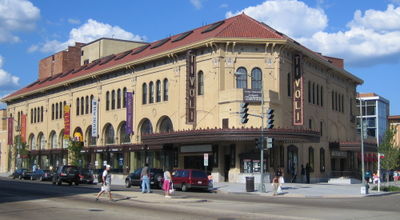      |
||||||||||
|
Columbia
Heights
Columbia Heights is a neighborhood in central
Washington, D.C.
HistoryOnce farmland on the estate of the Holmead family (called "Pleasant Plains"), Columbia Heights was part of Washington County, District of Columbia (within the District but outside the borders of the city of Washington. The southern edge of Columbia Heights is Florida Avenue, which was originally called "Boundary Street" because it formed the northern boundary of the Federal City). Construction of Columbia College began there in 1822. The area began developing as a suburb of Washington soon after the Civil War when horse-drawn streetcars delivered residents of the neighborhood to downtown. The northern portion of modern-day Columbia Heights (i.e., north of where Harvard Street currently lies) was, until the 1880s, a part of the village of Mount Pleasant. The southern portion still retained the name of the original Pleasant Plains estate. In 1878, Congress passed the DC Organic Act of 1878, which eliminated Washington County by extending the boundaries of Washington City to be contiguous with those of the District of Columbia. Shortly afterward, in 1881–82, Senator John Sherman, author of the Sherman Antitrust Act, purchased the land north of Boundary Street between 16th Street and 10th Street, developing it as a subdivision of the city called Columbia Heights — named for the college at its heart. (The neighborhood's eastern boundary and major traffic artery, Sherman Avenue, is named after its early developer.) Much of Sherman's purchase was of Columbia College's land, which it sold off in order to purchase a tract in the Foggy Bottom neighborhood, where it moved in 1884 and renamed itself George Washington University. The federal government also purchased some of the college's land and built Meridian Hill Park in the early 20th century. The park, also known as "Malcolm X Park", contains many statues including those of Joan of Arc, Dante and James Buchanan. Upscale development in Columbia Heights circa 1900, was designed to attract upper level managers of the Federal government, U.S. Supreme Court justices, and high-ranking military officers. An imposing mansion known as “Belmont” marked the imposing entrance to the neighborhood between Florida and Clifton Streets. The mansion was emblematic of the confidence that the affluent placed in the concept that Columbia Heights represented the ideal suburb. In the early 1900s, Columbia Heights was the preferred area for some of Washington’s wealthiest and most influential people. Residents included author Sinclair Lewis, Chief Justice Melville Fuller, and Justice John Marshall Harlan. In 1904, the Columbia Heights Citizen’s Association published an illustrated brochure entitled "A Statement of Some of the Advantages of Beautiful Columbia Heights." The publication describes Columbia Heights as a “residential section populated by public and spirited citizens.” Residents at that time were “ever alive to the mental, moral, and spiritual advancements of their homes surroundings.” The neighborhood organization sponsored competitions for landscaping house lots and offered prizes to the best kept lawn and garden, at the same time fought the erection of street poles and overhead telegraph and telephone lines. By 1914, four street car lines served the section providing transportation to downtown Washington in twenty minutes.
The neighborhood was adjacent to Washington's thriving middle class black community and came to be home to some of its most notable citizens by the 1930s. Duke Ellington, who had grown up in Shaw, purchased his first house at 2728 Sherman Avenue in Columbia Heights. Central High School, which bordered the southern edge of Columbia Heights, was renamed Cardozo High School when the school district deemed it a "colored" school in 1949. This took place seven years prior to nationwide school desegregation in 1956. Significant demographic changes began in the late 1940s when African American residents began to occupy homes previously owned by white students. The neighborhood remained a middle-class African American enclave in Washington, along with the nearby Shaw and Cardozo neighborhoods and Howard University through the mid-1960s. In 1968, following the assassination of Martin Luther King, Jr., riots ravaged Columbia Heights along with many other Washington neighborhoods. Many homes and shops remained vacant for decades.
DemographicsThe 2000 census figures estimated Columbia Heights with a 58
percent
African American population; 34 percent Hispanic population; 5.4
percent white population; and 3.1 percent other. [2] [3] The 2010 census figures estimated Columbia Heights with a 43.5
percent African American population; 28.1 percent Hispanic population;
22.9 percent White population; 3.2 percent Asian population; and a 2
percent Other population. In 2012, Columbia Heights was named one of
the fastest gentrifying neighborhoods in the United States. [4] Local institutionsIn January 2005, the neighborhood became the first permanent home of the GALA Hispanic Theatre which moved into the newly refurbished Tivoli Theatre, a former movie theater built in 1924 that had been vacant since 1976. GALA is a theater company dedicated to performing Spanish-language plays. In November of 2006, the Dance Institute of Washington opened a new 12,000 square foot (1100 m²) facility across the street from the Tivoli Theater.
EducationResidents are zoned to District of Columbia Public Schools. Public schools in Columbia Heights include: High schools:
Middle schools:
Elementary schools:
Public Charter Schools
[1]
"The
Target is Open! The Target is Open!", dcist.com, March 5,
2008
Information
provided by Wikipedia.org[2] DC USA at Columbia Heights News, accessed 2007-09-26 [3] DC USA, Bower Lewis Thower Architects [4] Report: D.C. white population grown rapidly in 3 ZIP codes, WJLA. Retrieved 1 August 2012.  |
||||||||||




